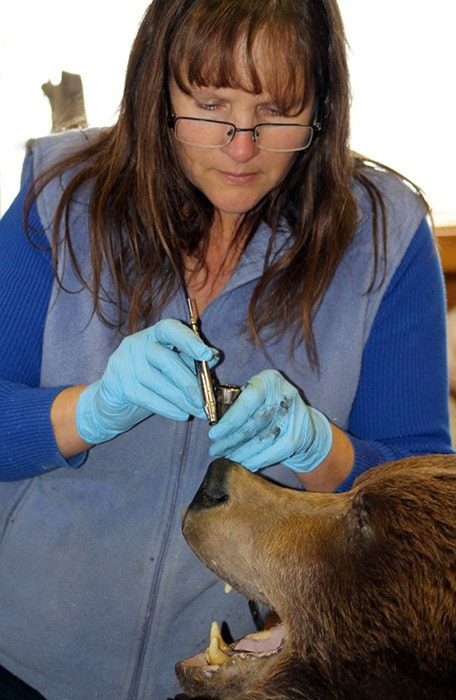Heidi Hills’ office isn’t your typical work environment. There are no office chairs, computers or filing cabinets, instead her work space is filled with the hides of bears, elk and wolves.
Hill owns and operates Blue Mountain Taxidermy on her ranch located in between Vanderhoof and Fort St. James.
Her work inhabits the grey space between the bucolic pastures that surround her log home and the often morbid association the public has with taxidermy.
A taxidermist since 2006 Hill says that taxidermy was a natural choice for her given her upbringing.
“I grew up working in an outfitting business and I was always involved in hunting as a child and I still am today… I always enjoyed working with it [the hides] and bringing them, in a sense, back to life.”
Hill works with her apprentice, Hannah Steffey, completing taxidermy jobs for clients as local as Vanderhoof and Fort St. James and as global as Europe and the United Kingdom.
Hill and Steffey primarily work with wild game animals such as deer, elk, bear, moose, coyotes and wolves but Hill admits she’s had clients request other animals.
“I was asked to do a dog once,” Hill says. “Someones pet dog - I don’t do those.”
Hill also doesn’t taxidermy fish, although she does know how to.
“I don’t really mount fish for clients. I have before and we occasionally do a fish for a life-sized diorama… but as far as anyone wanting a fish, we don’t do those. It’s a different kind of artwork.”
Most of her material comes from hunters who use the meat for food and Hill says through taxidermy the skins of the animals don’t go to waste.
Taxidermy is an often overlooked art form that shies away from the spotlight; it is a blue-collar artform in the truest sense of the word but that doesn’t mean that it doesn’t require the same finesse and level of skill that other, more mainstream artforms require. Taxidermy requires math (used when stretching and forming a hide), painting, sculpture and an understanding of anatomy. This is represented particularly well in the taxidermy of fish, who when dead lose their magnificent colourings, colouring that artists like Hill do by hand to recreate the animals natural beauty.
In order to learn and perfect her craft, Hill attended two different schools where she studied taxidermy, the Penn School of Taxidermy in Calgary as well as the Missoula Valley School of Taxidermy in Thompson Falls, Mont.
There she learned the intricacies of taxidermy.
“It’s a step program,” she says. “If someone brings you a full wolf or coyote it’s in a body form, so you have to skin it, most of them are skinned already, but if they’re not we flesh them [removing excess meat off of the hide]. Then it gets salted and dried before being sent to a tannery.”
Hill’s hides are sent to a tannery in Kamloops.
“When it comes back I can measure the hide, order the form [the base shape of the animal being taxidermied] and then fit it to the form and glue it on. After that we let it dry and then the bases are designed and once they’re dry we do some sculpting with clay and finally airbrush the model.”
The process requires a lot of dexterity as taxidermists must be both visual artists, seamstresses and butchers.
Steffey was originally hired because she was a known seamstress to Hill.
“I knew [Steffey] and her family through the fairgrounds and I knew she was a hard working country girl and that she liked to sew,” says Hill. “When I hired her I needed someone to sew bear rugs. She came and tried it out and she liked it.”
Steffey is poised to take over Hills operation when hill retires.
Taxidermy as an industry is not in the decline Hill says but it also isn’t growing.
“A lot of taxidermy businesses have shut down in Prince George as the owners get older and there is no one to take over the business,” she says. Despite this Hill is optimistic that taxidermy has future thanks to the increase in interest towards hunting and wild meat.
“I think as long as hunting continues, and hunting has increased in popularity due in part to the benefits of wild meat, I think because of that taxidermy could actually grow in the future.”
Most of Hill and Steffey’s work is client based with clients brining in hunted animals or road kill (most often owls) but she does sometimes sell her work.
“A bear skin rug sells for about $210 per foot, so six feet times $210 equals your price.”
